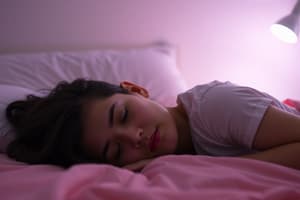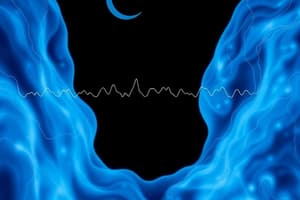Podcast
Questions and Answers
What is the role of casein kinase 1 delta in circadian rhythm?
What is the role of casein kinase 1 delta in circadian rhythm?
- Regulates the pace of the mammalian circadian clock (correct)
- Inhibits the function of cryptochrome
- Disrupts the binding of clock repressor proteins
- Promotes the expression of light-responsive genes
Melatonin receptor agonists are not used in regulating circadian rhythm sleep disorders.
Melatonin receptor agonists are not used in regulating circadian rhythm sleep disorders.
False (B)
What does the Period3 gene polymorphism affect?
What does the Period3 gene polymorphism affect?
Light modulation of human sleep
Which treatment option is commonly associated with adjusting circadian rhythms?
Which treatment option is commonly associated with adjusting circadian rhythms?
Light therapy is ineffective in treating circadian rhythm sleep disorders.
Light therapy is ineffective in treating circadian rhythm sleep disorders.
The histone methyltransferase ______ contributes to genome-scale circadian transcription.
The histone methyltransferase ______ contributes to genome-scale circadian transcription.
Match the following terms with their descriptions:
Match the following terms with their descriptions:
Name a common physiological function regulated by circadian rhythms.
Name a common physiological function regulated by circadian rhythms.
Which of these is a major component involved in the feedback loop of the circadian clock?
Which of these is a major component involved in the feedback loop of the circadian clock?
_______ receptors in the body are known to be affected by light exposure and are crucial in the regulation of circadian rhythms.
_______ receptors in the body are known to be affected by light exposure and are crucial in the regulation of circadian rhythms.
Match the following treatment options with their effects on circadian rhythms:
Match the following treatment options with their effects on circadian rhythms:
Proteasomes have no effect on circadian clock functioning.
Proteasomes have no effect on circadian clock functioning.
What is the primary focus of multimodal therapy strategies in relation to circadian rhythms?
What is the primary focus of multimodal therapy strategies in relation to circadian rhythms?
What types of conditions can light therapy help treat?
What types of conditions can light therapy help treat?
Circadian rhythms have no influence on mental health and emotional well-being.
Circadian rhythms have no influence on mental health and emotional well-being.
What physiological process does melatonin primarily influence?
What physiological process does melatonin primarily influence?
Which treatment option is specifically associated with the management of non-24-hour sleep-wake syndrome?
Which treatment option is specifically associated with the management of non-24-hour sleep-wake syndrome?
Melatonin receptor agonists are ineffective in treating circadian rhythm disorders.
Melatonin receptor agonists are ineffective in treating circadian rhythm disorders.
Name one disorder associated with circadian rhythm disruption that can be treated with light therapy.
Name one disorder associated with circadian rhythm disruption that can be treated with light therapy.
Tasimelteon is classified as a selective ______ receptor agonist.
Tasimelteon is classified as a selective ______ receptor agonist.
Match the following sleep disorders with their characteristics:
Match the following sleep disorders with their characteristics:
Which of the following factors can affect the physiology of circadian rhythms?
Which of the following factors can affect the physiology of circadian rhythms?
Circadian rhythm disorders are primarily associated with physical health and have no impact on mental health.
Circadian rhythm disorders are primarily associated with physical health and have no impact on mental health.
What is the focus of multimodal therapy strategies for sleep disorders?
What is the focus of multimodal therapy strategies for sleep disorders?
Flashcards
Circadian rhythm sleep disorders
Circadian rhythm sleep disorders
Conditions that disrupt the natural sleep-wake cycle, often due to problems with the body's internal clock.
Clock gene Period3
Clock gene Period3
A gene involved in regulating the human sleep-wake cycle, and light affects it.
Histone methyltransferase MLLI
Histone methyltransferase MLLI
An enzyme that regulates circadian gene expression by modifying histones.
Histone methyltransferase MLL3
Histone methyltransferase MLL3
Signup and view all the flashcards
Proteasomes
Proteasomes
Signup and view all the flashcards
PER phosphorylation
PER phosphorylation
Signup and view all the flashcards
Circadian clock
Circadian clock
Signup and view all the flashcards
Casein kinase 1 & protein phosphatase 1
Casein kinase 1 & protein phosphatase 1
Signup and view all the flashcards
Melanopsin-containing retinal ganglion cells
Melanopsin-containing retinal ganglion cells
Signup and view all the flashcards
Non-24-Hour Sleep-Wake Disorder
Non-24-Hour Sleep-Wake Disorder
Signup and view all the flashcards
Irregular Sleep-Wake Disorder
Irregular Sleep-Wake Disorder
Signup and view all the flashcards
Shift Work Disorder
Shift Work Disorder
Signup and view all the flashcards
Jet Lag
Jet Lag
Signup and view all the flashcards
Cancer risk and circadian rhythms
Cancer risk and circadian rhythms
Signup and view all the flashcards
Non-24-hour sleep-wake rhythm disorder (N24SWD)
Non-24-hour sleep-wake rhythm disorder (N24SWD)
Signup and view all the flashcards
Advanced sleep-wake phase disorder (ASWPD)
Advanced sleep-wake phase disorder (ASWPD)
Signup and view all the flashcards
Delayed sleep-wake phase disorder (DSWPD)
Delayed sleep-wake phase disorder (DSWPD)
Signup and view all the flashcards
Irregular sleep-wake rhythm disorder (ISWRD)
Irregular sleep-wake rhythm disorder (ISWRD)
Signup and view all the flashcards
Tasimelteon
Tasimelteon
Signup and view all the flashcards
Sleep-wake cycle
Sleep-wake cycle
Signup and view all the flashcards
Genetic basis of circadian rhythm disorders
Genetic basis of circadian rhythm disorders
Signup and view all the flashcards
Study Notes
Non-24-Hour Sleep-Wake Disorder
- A circadian rhythm sleep disorder affecting up to 50% of completely blind individuals
- Characterized by the inability to maintain a stable entrainment (synchronization) of a typically long circadian rhythm (tau > 24.5 hours) to the light-dark cycle (LD cycle)
- Less common in sighted individuals
- Pathophysiology less understood
- Tau is the circadian rhythm period length (e.g., 25.27 hours)
Case Study Details
- 40-year-old sighted male developed the disorder after cancer chemotherapy (Hodgkin's lymphoma) with ABVD or AVD regimens
- Actigraphy, melatonin profiles, and polysomnography diagnosed the condition with a free-running rhythm of tau = 25.27 hours
- Bright light therapy (10,000 lux for 30 minutes) and melatonin administration (0.5-0.75 mg) failed to resynchronize the internal clock
- Treatment caused headaches and did not entrain the free-running rhythm
- Patient continued with the light therapy after discontinuing melatonin because it improved attentiveness and concentration during wakefulness.
Human Sleep-Wake Cycle
- Governed by two major processes:
- Homeostatic hourglass process (process S): Increases linearly during the day
- Circadian process (process C): Determines sleep timing in a ~24-hour rhythm, synchronized to the light-dark (LD) cycle
- Suprachiasmatic nucleus (SCN) in the anterior hypothalamus is the master clock
- SCN generates the circadian rhythm through cell-autonomous feedback loops of DNA transcription and translation
- Phase length (tau) is relatively stable and genetically determined
- Phase of the clock (timing) is reset by external stimuli (zeitgebers), the most important being the light-dark cycle
- Misalignment between internal rhythm and LD cycle is a contributor to circadian rhythm sleep disorders (CRSD)
Molecular Clock
- Genetically encoded system for anticipation and adaptation to daily/seasonal variations
- Consist of positive and negative feedback mechanisms involving DNA translation
- Involves the transcription factors CLOCK and BMAL1 in initiating the expression of genes (PERIOD, CRYPTOCHROME)
- These proteins inhibit the CLOCK/BMAL1 expression, creating a feedback loop, thus generating a circadian rhythm
N24HSWD Treatment
- Treatment aimed at resynchronizing the long (~25 hours) sleep-wake cycle with the 24-hour day
- Bright light therapy (morning) and melatonin administration (evening) are strategies but may not always result in resynchronization
- Multiple factors including individual differences, strength of circadian rhythm oscillation, and responsiveness to interventions influence treatment outcome
Circadian Rhythm Sleep Disorders (CRSD)
- Includes conditions like shift work sleep disorder, advanced sleep phase syndrome, delayed sleep phase syndrome, jet lag, and non-24-hour sleep-wake disorders (N24HSWD)
- Characterized by misalignment between the internal clock and the external light-dark cycle
Studying That Suits You
Use AI to generate personalized quizzes and flashcards to suit your learning preferences.




